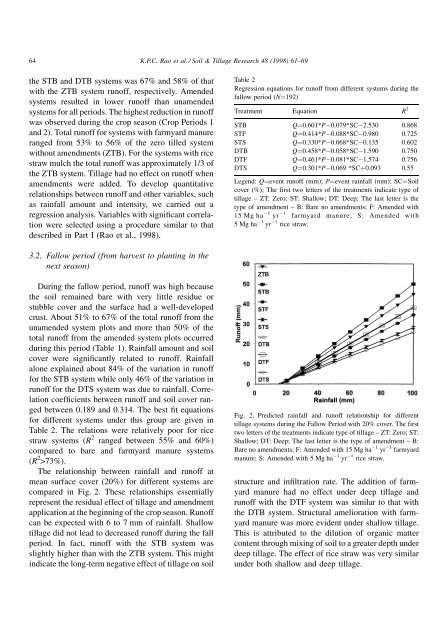Rainfall infiltration and runoff from an Alfisol in semi-arid tropical ...
Rainfall infiltration and runoff from an Alfisol in semi-arid tropical ...
Rainfall infiltration and runoff from an Alfisol in semi-arid tropical ...
Create successful ePaper yourself
Turn your PDF publications into a flip-book with our unique Google optimized e-Paper software.
64 K.P.C. Rao et al. / Soil & Tillage Research 48 (1998) 61±69<br />
the STB <strong><strong>an</strong>d</strong> DTB systems was 67% <strong><strong>an</strong>d</strong> 58% of that<br />
with the ZTB system <strong>runoff</strong>, respectively. Amended<br />
systems resulted <strong>in</strong> lower <strong>runoff</strong> th<strong>an</strong> unamended<br />
systems for all periods. The highest reduction <strong>in</strong> <strong>runoff</strong><br />
was observed dur<strong>in</strong>g the crop season (Crop Periods 1<br />
<strong><strong>an</strong>d</strong> 2). Total <strong>runoff</strong> for systems with farmyard m<strong>an</strong>ure<br />
r<strong>an</strong>ged <strong>from</strong> 53% to 56% of the zero tilled system<br />
without amendments (ZTB). For the systems with rice<br />
straw mulch the total <strong>runoff</strong> was approximately 1/3 of<br />
the ZTB system. Tillage had no effect on <strong>runoff</strong> when<br />
amendments were added. To develop qu<strong>an</strong>titative<br />
relationships between <strong>runoff</strong> <strong><strong>an</strong>d</strong> other variables, such<br />
as ra<strong>in</strong>fall amount <strong><strong>an</strong>d</strong> <strong>in</strong>tensity, we carried out a<br />
regression <strong>an</strong>alysis. Variables with signi®c<strong>an</strong>t correlation<br />
were selected us<strong>in</strong>g a procedure similar to that<br />
described <strong>in</strong> Part I (Rao et al., 1998).<br />
3.2. Fallow period (<strong>from</strong> harvest to pl<strong>an</strong>t<strong>in</strong>g <strong>in</strong> the<br />
next season)<br />
Dur<strong>in</strong>g the fallow period, <strong>runoff</strong> was high because<br />
the soil rema<strong>in</strong>ed bare with very little residue or<br />
stubble cover <strong><strong>an</strong>d</strong> the surface had a well-developed<br />
crust. About 51% to 67% of the total <strong>runoff</strong> <strong>from</strong> the<br />
unamended system plots <strong><strong>an</strong>d</strong> more th<strong>an</strong> 50% of the<br />
total <strong>runoff</strong> <strong>from</strong> the amended system plots occurred<br />
dur<strong>in</strong>g this period (Table 1). <strong>Ra<strong>in</strong>fall</strong> amount <strong><strong>an</strong>d</strong> soil<br />
cover were signi®c<strong>an</strong>tly related to <strong>runoff</strong>. <strong>Ra<strong>in</strong>fall</strong><br />
alone expla<strong>in</strong>ed about 84% of the variation <strong>in</strong> <strong>runoff</strong><br />
for the STB system while only 46% of the variation <strong>in</strong><br />
<strong>runoff</strong> for the DTS system was due to ra<strong>in</strong>fall. Correlation<br />
coef®cients between <strong>runoff</strong> <strong><strong>an</strong>d</strong> soil cover r<strong>an</strong>ged<br />
between 0.189 <strong><strong>an</strong>d</strong> 0.314. The best ®t equations<br />
for different systems under this group are given <strong>in</strong><br />
Table 2. The relations were relatively poor for rice<br />
straw systems (R 2 r<strong>an</strong>ged between 55% <strong><strong>an</strong>d</strong> 60%)<br />
compared to bare <strong><strong>an</strong>d</strong> farmyard m<strong>an</strong>ure systems<br />
(R 2 >73%).<br />
The relationship between ra<strong>in</strong>fall <strong><strong>an</strong>d</strong> <strong>runoff</strong> at<br />
me<strong>an</strong> surface cover (20%) for different systems are<br />
compared <strong>in</strong> Fig. 2. These relationships essentially<br />
represent the residual effect of tillage <strong><strong>an</strong>d</strong> amendment<br />
application at the beg<strong>in</strong>n<strong>in</strong>g of the crop season. Runoff<br />
c<strong>an</strong> be expected with 6 to 7 mm of ra<strong>in</strong>fall. Shallow<br />
tillage did not lead to decreased <strong>runoff</strong> dur<strong>in</strong>g the fall<br />
period. In fact, <strong>runoff</strong> with the STB system was<br />
slightly higher th<strong>an</strong> with the ZTB system. This might<br />
<strong>in</strong>dicate the long-term negative effect of tillage on soil<br />
Table 2<br />
Regression equations for <strong>runoff</strong> <strong>from</strong> different systems dur<strong>in</strong>g the<br />
fallow period (Nˆ192)<br />
Treatment Equation R 2<br />
STB Qˆ0.601*P 0.079*SC 2.530 0.868<br />
STF Qˆ0.414*P 0.088*SC 0.980 0.725<br />
STS Qˆ0.330*P 0.068*SC 0.135 0.602<br />
DTB Qˆ0.458*P 0.058*SC 1.590 0.750<br />
DTF Qˆ0.461*P 0.081*SC 1.574 0.756<br />
DTS Qˆ0.301*P 0.069 *SC‡0.093 0.55<br />
Legend: Qˆevent <strong>runoff</strong> (mm); Pˆevent ra<strong>in</strong>fall (mm); SCˆSoil<br />
cover (%); The first two letters of the treatments <strong>in</strong>dicate type of<br />
tillage ± ZT: Zero; ST: Shallow; DT: Deep; The last letter is the<br />
type of amendment ± B: Bare no amendments; F: Amended with<br />
15 Mg ha 1 yr 1<br />
farmyard m<strong>an</strong>ure; S: Amended with<br />
5 Mg ha 1 yr 1 rice straw.<br />
Fig. 2. Predicted ra<strong>in</strong>fall <strong><strong>an</strong>d</strong> <strong>runoff</strong> relationship for different<br />
tillage systems dur<strong>in</strong>g the Fallow Period with 20% cover. The first<br />
two letters of the treatments <strong>in</strong>dicate type of tillage ± ZT: Zero; ST:<br />
Shallow; DT: Deep; The last letter is the type of amendment ± B:<br />
Bare no amendments; F: Amended with 15 Mg ha 1 yr 1 farmyard<br />
m<strong>an</strong>ure; S: Amended with 5 Mg ha 1 yr 1 rice straw.<br />
structure <strong><strong>an</strong>d</strong> <strong>in</strong>®ltration rate. The addition of farmyard<br />
m<strong>an</strong>ure had no effect under deep tillage <strong><strong>an</strong>d</strong><br />
<strong>runoff</strong> with the DTF system was similar to that with<br />
the DTB system. Structural amelioration with farmyard<br />
m<strong>an</strong>ure was more evident under shallow tillage.<br />
This is attributed to the dilution of org<strong>an</strong>ic matter<br />
content through mix<strong>in</strong>g of soil to a greater depth under<br />
deep tillage. The effect of rice straw was very similar<br />
under both shallow <strong><strong>an</strong>d</strong> deep tillage.








